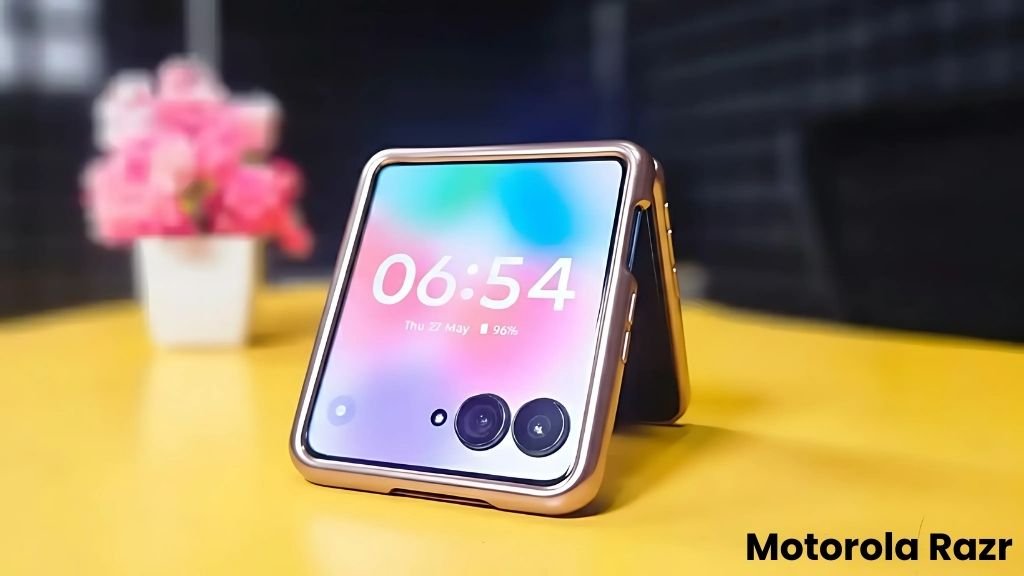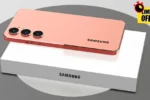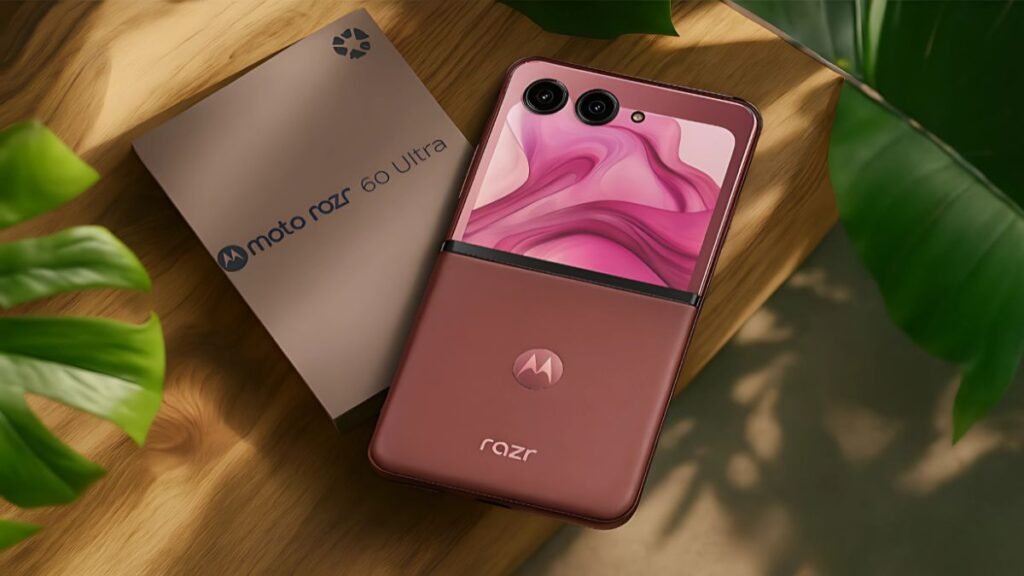Motorola Razr 60 Launched: Phones got tall. Then they folded. Now they’re finally fun again. With the Motorola Razr 60, the flip form isn’t a novelty—it’s a thoughtful daily driver with a capable chip, a big inner display, a genuinely useful cover screen, and a price that undercuts a lot of competitors. In this long, plain-English guide, we unpack the launch, specs, strengths, trade-offs, and exactly who should put the Razr 60 in their pocket.
Launch Snapshot: Dates, Markets, Colors, and What’s in the Box
The Razr 60 landed in mid-2025 with India as an early headline market, followed by other regions, carrier tie-ups, and limited editions. India got the 8 GB/256 GB variant at a list price around ₹49,999, with sales rolling out through major online channels and retail partners. First-wave colorways included Pantone Lightest Sky, Pantone Spring Bud, and Pantone Gibraltar Sea—three finishes that make the phone feel fashion-forward instead of corporate. Outside India, regional pricing varies with retailer exclusives and early-bird promos. In short: the Razr 60 launched as a mainstream flip, not a halo toy, with colors and bundles that lean into its lifestyle angle.
Design & Build: A Flip That Feels Thought-Through
Motorola’s clamshell language keeps getting cleaner. Closed, the Razr 60 presents a tidy rectangle with a near-square cover screen and a finish that actually invites you to use it caseless—especially in the soft-touch Pantone shades. Open it up and the symmetry clicks: the hinge feels confident, tolerances are tight, and there’s minimal wobble when you poke at the upper half. Durability testing runs into the hundreds of thousands of folds, which isn’t a brag for brag’s sake—if you flip your phone 150–200 times a day, that headroom matters over years. The vibe is less “delicate gadget” and more “compact companion”: slim in a pocket, stable in the hand, and designed to be used one-handed for quick interactions on the cover before you commit to the big screen inside.
Displays: Big 6.9″ pOLED Inside, Handy 3.6″ Outside
The inner display is a 6.9-inch FHD+ pOLED canvas running at 120 Hz—smooth, saturated, and large enough that you stop missing a slab almost immediately. Text is crisp, scrolling has that liquid feel, and HDR content looks lively without going cartoonish. Outdoors, brightness is robust enough to keep maps and chats legible in strong sun. The 3.6-inch cover display does more than time and notifications: quick replies, music controls, camera framing, and bite-sized widgets all run comfortably here, which seriously reduces “open phone for nothing” moments. For creators, the cover screen also doubles as a proper preview for the rear camera, so your selfies jump in quality by default.
Performance & Chipset: Quietly Fast with MediaTek Dimensity 7400X
Under the hood beats MediaTek’s Dimensity 7400X, paired in most markets with 8 GB RAM and 256 GB storage. This isn’t a synthetic-benchmark monster; it’s a “never makes you wait” engine for everyday life. App launches are crisp, camera-to-share workflows stay snappy, and the phone keeps its cool during streaming, maps, and batch photo edits. For heavier titles, you’ll want to dial graphics down a notch—this is a lifestyle flip, not an esports rig—but for the tasks 95% of us actually do, the Razr 60 feels predictably smooth. Motorola also sprinkles in AI features like notification summaries, live translation with speaker identification, and on-device smarts you can trigger right from the cover. It’s the kind of speed you notice because friction isn’t there.
Cameras: 50 MP Main with OIS, 13 MP Ultrawide, 32 MP Selfie
Specs point to an honest setup instead of headline bait. The 50 MP main with OIS delivers clean daylight detail, realistic color, and respectable dynamic range without over-cranking sharpening. The 13 MP ultrawide is handy for cafés, groups, and cityscapes—best in good light, as expected. And the 32 MP selfie becomes something better: flip the phone and use the rear camera with the cover preview for higher-quality selfies and vlogs. Video is stable and crisp in daytime; at night, keep your movements gentle. Motorola’s extras—Photo Booth, Tent Mode, and stabilization tools—reward experimentation and make the flip feel purposeful, not just nostalgic.
Battery & Charging: 4,500 mAh, 30 W Wired, 15 W Wireless
Foldables often compromise here, but the Razr 60’s 4,500 mAh pack is generous for this form factor. A standard day of mixed use—messages, reels, maps, camera bursts, and a couple of calls—lands you home with gas in the tank. 30 W TurboPower™ is quick enough for meaningful top-ups during a coffee, and 15 W wireless keeps desks tidy. Practical tip: keep adaptive refresh on, lean on the cover screen for quick glances, and you’ll stretch runtime without thinking about it. This is “forget about the charger until evening” stamina, not “carry a power bank everywhere” anxiety.
Software, AI & Everyday Flow
Out of the box, Razr 60 ships with the latest Android build for its launch window, wrapped in Motorola’s tasteful light-touch customizations. The Moto AI layer sits quietly until you need it: suggestive actions on screen, voice-prompted tasks, and cover-screen interactions that trim taps. The result is an OS that feels helpful, not pushy—you won’t be buried under features you’ll never remember. Think “finish tasks faster” instead of “learn a new system.” And because the cover display runs real widgets and interactions, you’ll discover you can triage a surprising amount without opening the phone at all. That’s the flip superpower: fewer interruptions, more intention.
Durability & Hinge Confidence
The hinge is the soul of a flip. Motorola rates the mechanism for well over 500,000 folds, which translates to years of everyday use even for constant flippers. The motion is controlled rather than floppy; it stays where you set it for desk-mode selfies, top-down cooking videos, or dual-screen glances. While foldable displays will always prefer pockets free of granules and keys, the Razr 60’s overall construction—tight tolerances, confidence in the spine, and a sensible lip when closed—gives it a reassuring feel. Treat it like good eyewear, not a Fabergé egg, and it should age gracefully.
Connectivity & Sound: The Daily-Driver Basics
You get broad 5G coverage (market-dependent bands), dependable LTE fallback, dual-SIM options in many regions, Bluetooth and Wi-Fi tuned for modern routers, NFC in markets where tap-to-pay is standard, and USB-C with fast data and charging. Audio is above average for a flip, helped by dual stereo speakers—podcasts sound full, voice is clear, and casual music sessions don’t feel tinny. For calls, the earpiece tuning favors intelligibility over bass, which is exactly right on noisy commutes. It’s everything you need to stop thinking about connection logistics and get on with your day.
Price Watch: MRP vs Street, and a Limited Edition Twist
On day one in India, Razr 60 arrived near ₹49,999 for the 8 GB/256 GB variant; as sales matured, street pricing dipped around ₹39,999 during promotions—solid value against rival flips and even some non-folding mid-premiums. Elsewhere, regional RRPs and retailer exclusives defined the first months of availability. If you’re the collector type, a Swarovski-style special edition with a crystalline design flourish appeared in limited windows. Pro tip: calculate effective price (MRP – bank offer – exchange – launch coupon) rather than fixating on sticker. That’s your real out-of-pocket.
Razr 60 vs Razr 60 Ultra: Which One Makes Sense?
Motorola’s “Ultra” trims are about maximum horsepower. The Razr 60 Ultra pairs the external display with a flagship-class Snapdragon platform and more aggressive memory options, aimed at creators and power users who stress every subsystem daily. The Razr 60 keeps things practical: efficient mid-high silicon, the same delightful flip ergonomics, and a price that leaves headroom for accessories or future trade-ins. If you edit long 4K clips, game hard, or want the fastest on-device AI, the Ultra earns its badge. If you’re buying for smoother days, quick captures, and a calmer wallet, the standard Razr 60 is the smart pick.
Who the Razr 60 Is Perfect For
If your daily routine is a loop of messaging, maps, camera bursts, Insta/TikTok, and YouTube, the Razr 60 feels built for you. Students and commuters will love the pocketability; travelers get a cover screen that slashes unlocks; parents gain a compact camera that’s always ready. If you want the flip experience without the flagship tax, this hits the Goldilocks zone. On the flip side, if you chase max night-mode wizardry, highest-tier GPU performance, or 100W charging, a different class of phone (or the Ultra) will better fit those edges. The Razr 60 is about balance and joy—not brute force.





